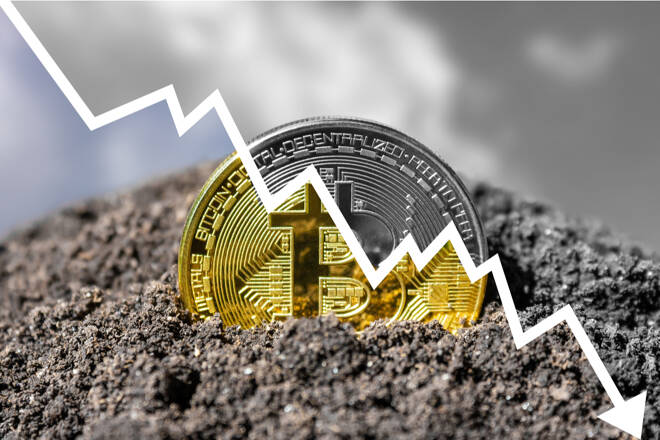Advertisement
Advertisement
Bitcoin Hasn’t Hit Rock Bottom Yet: Is The Crypto Winter Going to End or Has It Only Just Begun?
By:
The second quarter of 2022 was the worst performance period for Bitcoin (BTC-USD) in the last 11 years, as its price collapsed by almost 60% from $45,000 to less than $19,000.
The price of Ethereum (ETH-USD) has also dropped by nearly 70% over the past three months for the first time in the history of the largest altcoin by capitalization.
The crisis in the cryptocurrency market has led to massive layoffs and liquidations in many large crypto companies, and crypto lending platforms are now under threat of bankruptcy. Coinbase and Crypto.com announced more than 1400 layoffs, the largest crypto investment fund Three Arrows Capital went into liquidation, and lending company Celsius suspended withdrawals for customers.
Mining companies faced difficulties due to falling profitability and began to sell mined Bitcoins to pay their operating costs and cover loans.
External Factor Pressure
The price of Bitcoin is largely correlated with the situation in the US stock market. The stock sell-off has seriously impacted Bitcoin and the crypto market as investors are doing away with risky assets.
In the second quarter, the US Federal Reserve implemented two aggressive interest rate hikes to cope with record-high inflation, fueling fears of a global recession. As a result, the percentage-wise decline in traditional asset indices has reached double-digit values.
The hardest hit were the stocks of high-growth technology names — the Nasdaq Composite dropping by 22.4% in the second quarter and showing its worst quarterly performance over 14 years.
Bitcoin has never experienced such strong pressure from external factors as it is now. Since the beginning of the year, the cryptocurrency has lost 57.3% in price, twice as much as the S&P 500 (-20.6%). Those who bought shares of companies such as PayPal (-64.2%), Netflix (-70%) and Shopify (-77%), suffered more losses. Even classic portfolio strategies in the US are showing their worst performance since the 2008 global financial crisis.
Still Falling
There are no reasons in sight for a change in the global downtrend in the market. From the point of view of macro prospects, a change in the trend for Bitcoin is possible only with the change in the rhetoric of the US Federal Reserve to a friendlier stance towards the stock markets. The prerequisite is the normalization of inflation and the stabilization of the economy.
Even worse, the likelihood of a further price decline is only increasing. In his recent speech to the US Congress, the head of the Fed acknowledged that there is a possibility of a recession. Previously, high growth in food prices against the backdrop of low unemployment was a typical picture on the eve of economic downturns.
The negative sentiment towards digital currencies on the part of regulators was exacerbated by the collapse of the TerraUSD stablecoin, as a result of which global authorities started talking about the shortcomings of the digital currency market and the need for stricter regulation.
No End In Sight?
Improvements in the stock exchange market are unlikely in the near future, which means that the price of Bitcoin in the third quarter will not demonstrate growth. A lot will also depend on geopolitics, new economic measures, prices for commodities, and the results of the elections to the US Congress in early November.
Some experts predict a possible rebound in the price of Bitcoin to $25,000. But, subsequently, there is a high chance that the cryptocurrency will continue to fall and begin a long consolidation in search of price lows below the $10,000 mark. Psychological factors are also playing against Bitcoin.
During a downtrend, positive news does not contribute to cryptocurrency exchange rates growth, while negative news, on the contrary, has a negative effect on the price. New price lows can provoke traders to a new reset of the cryptocurrency throughout the market. On the other hand, it can be an entry point for market newcomers looking to take advantage of the low price.
In many ways, long-term investors are guided by 2024, when the next Bitcoin halving will take place. The price of the coin will most likely update its historical highs after the landmark event, just as it has in the past history of the oldest cryptocurrency.
In any case, it can be quite a risky venture to buy any cryptocurrency now, as top instruments may well lose another 50% to 70% of their current value.
About the Author
Julia Magascontributor
Julia Magas is a researcher/journalist who covers the latest trends in finance and technology. Her works are published on Cointelegraph, Investing, SeekingAlpha, Beincrypto, Coincodex, where she interviewed the representatives from MIT, Binance, IRS, Bitcoin Cash, Ethereum, Algorand, the Austrian government, Grant Thornton, and more.
Advertisement
